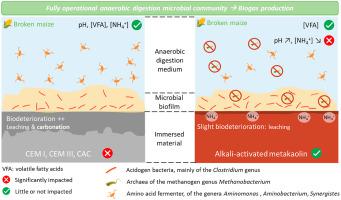Journal of Environmental Management ( IF 8.0 ) Pub Date : 2021-09-11 , DOI: 10.1016/j.jenvman.2021.113735 Marie Giroudon 1 , Cédric Perez 2 , Matthieu Peyre Lavigne 3 , Benjamin Erable 4 , Christine Lors 5 , Cédric Patapy 6 , Alexandra Bertron 6

|
Concrete structures of anaerobic digestion plants face chemically aggressive conditions due to the contact with the complex liquid fraction of the fermenting biowaste. This paper aims to determine the biogeochemical dynamic interaction phenomena at play between the biowaste and cementitious matrices at the local scale, and to identify durable binders in such environments. Binder materials likely to show increased durability – slag and calcium aluminate cement, and a metakaolin-based alkali-activated geopolymer – and a reference Portland cement were inserted into sealed bioeactors during 5 cycles (245 days) of broken maize anaerobic digestion. Cementitious pastes suffered chemical and mineralogical alteration related mainly to carbonation and leaching. However, they had no negative impact on the bioprocess in terms of pH, metabolic evolution of volatile fatty acids and NH4+, planktonic microbial community composition or CH4 production. In all reactors, the microbial community was able to perform the anaerobic digestion successfully. The MKAA was only slightly altered in its outermost layer. Its presence in the biowaste induced lower NH4+ concentrations, a slightly higher pH and a marked shift in the microbial community, but CH4 total production was not affected. Substantial enrichment of acid forming bacteria, especially members of the genus Clostridium, was observed in the biofilm formed on all materials.
中文翻译:

深入了解发酵破碎玉米与厌氧消化器结构的各种粘合剂材料之间的局部相互作用机制
由于与发酵生物废物的复杂液体部分接触,厌氧消化装置的混凝土结构面临化学侵蚀条件。本文旨在确定局部范围内生物废物和胶结基质之间的生物地球化学动态相互作用现象,并确定此类环境中的耐用粘合剂。在破碎玉米厌氧消化的 5 个周期(245 天)期间,将可能显示出更高耐久性的粘合剂材料——矿渣和铝酸钙水泥,以及偏高岭土碱活化地质聚合物——和参考波特兰水泥插入密封的生物反应器中。水泥浆遭受化学和矿物学改变,主要与碳化和浸出有关。然而,它们在 pH 值方面对生物过程没有负面影响,4 +,浮游微生物群落组成或CH 4产生。在所有反应器中,微生物群落都能成功进行厌氧消化。MKAA 仅在其最外层略有改变。它在生物废物中的存在导致较低的 NH 4 +浓度、略高的 pH 值和微生物群落的显着变化,但 CH 4总产量不受影响。在所有材料上形成的生物膜中观察到产酸细菌,尤其是梭菌属成员的大量富集。











































 京公网安备 11010802027423号
京公网安备 11010802027423号